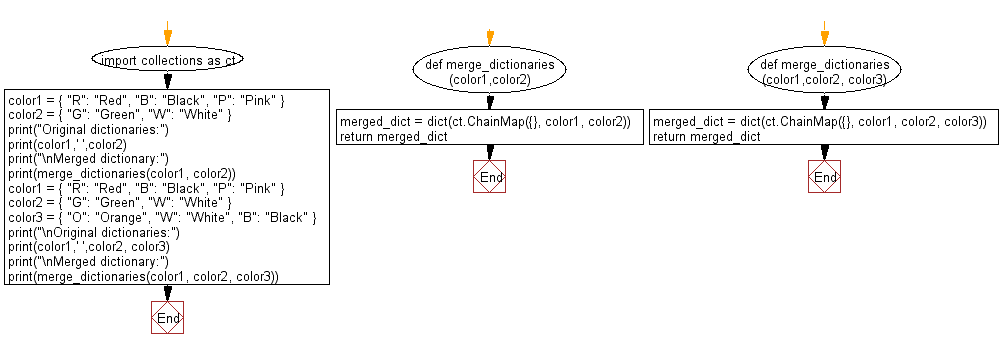Python: Merge more than one dictionary in a single expression
Python Collections: Exercise-18 with Solution
Write a Python program to merge more than one dictionary in a single expression.
Sample Solution:
Python Code:
import collections as ct
def merge_dictionaries(color1,color2):
merged_dict = dict(ct.ChainMap({}, color1, color2))
return merged_dict
color1 = { "R": "Red", "B": "Black", "P": "Pink" }
color2 = { "G": "Green", "W": "White" }
print("Original dictionaries:")
print(color1,' ',color2)
print("\nMerged dictionary:")
print(merge_dictionaries(color1, color2))
def merge_dictionaries(color1,color2, color3):
merged_dict = dict(ct.ChainMap({}, color1, color2, color3))
return merged_dict
color1 = { "R": "Red", "B": "Black", "P": "Pink" }
color2 = { "G": "Green", "W": "White" }
color3 = { "O": "Orange", "W": "White", "B": "Black" }
print("\nOriginal dictionaries:")
print(color1,' ',color2, color3)
print("\nMerged dictionary:")
# Duplicate colours have automatically removed.
print(merge_dictionaries(color1, color2, color3))
Sample Output:
Original dictionaries:
{'R': 'Red', 'B': 'Black', 'P': 'Pink'} {'G': 'Green', 'W': 'White'}
Merged dictionary:
{'B': 'Black', 'R': 'Red', 'P': 'Pink', 'G': 'Green', 'W': 'White'}
Original dictionaries:
{'R': 'Red', 'B': 'Black', 'P': 'Pink'} {'G': 'Green', 'W': 'White'} {'O': 'Orange', 'W': 'White', 'B': 'Black'}
Merged dictionary:
{'B': 'Black', 'R': 'Red', 'P': 'Pink', 'G': 'Green', 'W': 'White', 'O': 'Orange'}
Flowchart:

Visualize Python code execution:
The following tool visualize what the computer is doing step-by-step as it executes the said program:
Python Code Editor:
Have another way to solve this solution? Contribute your code (and comments) through Disqus.
Previous: Write a Python program to find the majority element from a given array of size n using Collections module.
Next: Write a Python program to break a given list of integers into sets of a given positive number. Return true or false.
What is the difficulty level of this exercise?
Test your Programming skills with w3resource's quiz.
Python: Tips of the Day
Find current directory and file's directory:
To get the full path to the directory a Python file is contained in, write this in that file:
import os dir_path = os.path.dirname(os.path.realpath(__file__))
(Note that the incantation above won't work if you've already used os.chdir() to change your current working directory, since the value of the __file__ constant is relative to the current working directory and is not changed by an os.chdir() call.)
To get the current working directory use
import os cwd = os.getcwd()
Documentation references for the modules, constants and functions used above:
- The os and os.path modules.
- The __file__ constant
- os.path.realpath(path) (returns "the canonical path of the specified filename, eliminating any symbolic links encountered in the path")
- os.path.dirname(path) (returns "the directory name of pathname path")
- os.getcwd() (returns "a string representing the current working directory")
- os.chdir(path) ("change the current working directory to path")
Ref: https://bit.ly/3fy0R6m
- New Content published on w3resource:
- HTML-CSS Practical: Exercises, Practice, Solution
- Java Regular Expression: Exercises, Practice, Solution
- Scala Programming Exercises, Practice, Solution
- Python Itertools exercises
- Python Numpy exercises
- Python GeoPy Package exercises
- Python Pandas exercises
- Python nltk exercises
- Python BeautifulSoup exercises
- Form Template
- Composer - PHP Package Manager
- PHPUnit - PHP Testing
- Laravel - PHP Framework
- Angular - JavaScript Framework
- Vue - JavaScript Framework
- Jest - JavaScript Testing Framework
